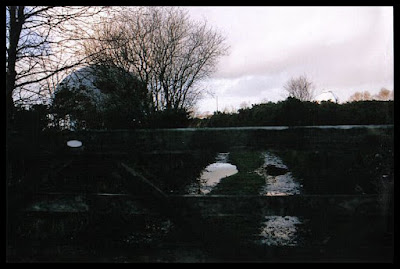I have a lot of single or a few images of odds and ends seen on my travels, some no longer there and some which have nowhere else to go, so I decided to put them all on one or two Odds & Ends posts.
The photo above of an old milk churn was taken on one of my walks to document the Axe Valley pillboxes in 2008/09. It was very old and coming apart then, so I don't know if it's still there or not, but definitely a photo I'm glad I took either way.
This fabulous cannon can be seen in the courtyard of an Exmouth Wetherspoon's pub called The Powder Monkey. Inside the pub a plaque reads...
'This J D Wetherspoon pub is named after Nancy Perriam, whose sewing skills earned her a berth in the Navy alongside her sailor husband. Nancy lived in nearby Tower Street until 1865, when she died in her 98th year.
A ‘powder monkey’ was naval slang for the young boys who filled shells and cartridges with gunpowder. As well as sewing shirts and sails, Nancy acted as a powder monkey, working alongside the gunners on board the Crescent and the Orion.'
These lovely old petrol pumps were situated outside a garage in Seaton, Devon. The garage used to be a service station for petrol and repairs but has been a car salesroom for as long as I can remember.
I'm really glad I decided to take photos of them and the garage with its erstwhile top and signage. They were kept like that long after the garage ceased being used as a petrol station. I took these circa 1992 with black & white film and intended to go back to take some more in colour. Sadly, they were taken away before I did and I missed my chance, but at least I've got these.
The Seaton Youth Centre, below, was demolished along with the old Blue Waters Holiday Camp and the Lyme Bay Holiday Village - which was originally Warner's - to build a Tesco supermarket and some houses (the so-called Seaton Regeneration). Another youth centre was never built or held elsewhere, which means there's no longer anywhere for youngsters to meet and get involved with activities together.
As well as youth activities there used to be a table top sale on a sunday morning, which was very popular. I hired a table myself and really got into selling, which was fun and which was sometimes helpful to make some money...and sometimes not, lol. Knowing it was about to be demolished I took this one photo for posterity.
A gatepost! That's all it is, in the middle of nowhere on the A3052 road which runs between Lyme Regis in Dorset and through East Devon to Exeter. I took this photo when on one of my long walks to explore some derelict buildings and I think it was near the old Lyme Bay Cider site, but doesn't appear to be connected with that - or anything - as there's nothing but a field behind it. Anyway, I liked it so I took the photo. :)
I was in a friend's car and we were driving through King's Down Tail, on the same long A3052 road, when we spotted this abandoned car in the undergrowth. So she pulled up and we got out to have a look.
And while I was there I took a couple of photos showing the road either way while there was no traffic. It looks just like a country lane in these photos but it's a different matter when it's busy and huge lorries thunder past. A bit terrifying when walking along and you can feel the force of the speed pulling you into them! This was lovely and quiet, though.
Just a fun article between the weightier ones. I've got quite a few of these kinds of photos but I'll add them on further posts every now and then as an occasional break from the usual stuff. Hope you found it interesting but I've kept it short in case it isn't, lol. Some more proper articles coming up soon. :)



















































